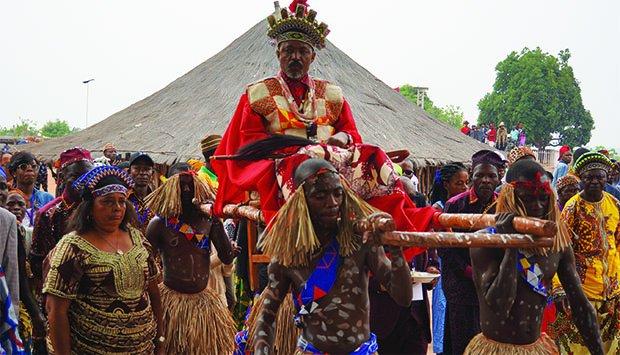Africa-Press – Angola. The entrance to the cemetery of the kings takes place in silence: dozens of sobas and regedores barefoot, a cash offering is placed in a basket, in the space between the gate and the grave area, where the seriousness of a couple of concrete lions emits, at first sight, a cautionary notice to the visitor.
Kneeling, with their hands resting on the floor, the participants descend to the trunk and raise their arms and clap their hands, like someone asking for permission to enter someone else’s house. Individual withdrawal heralds the introspection phase.
The submission illustrates the deification of the ancestors to, supposedly, “obtain blessing in the harvests, fecundity in families and protection against evil”, as the chief of the Carteira neighborhood, Francisco Yenu José, said, next to the fence wall, painted in white.
After the exhaustive tribute session to the nobles who enjoy eternal rest in the holy field is over, the participants leave the place without haste, putting on the shoes left at the entrance. For the mayor of Naxili, in the province of Lunda-Norte, Alberto Caxela Cadrela “the kings will solve the population’s problems, presented during the ritual, which reflects part of our identity”.
Cadrela fits the third commemoration of the Cokwe year, in the reign of the sovereign Lucassa João, in the efforts to rescue cultural values.
The Camoxi party is a special moment to pay homage to the ancestors in order to guarantee peace and prosperity. His counterpart from Cambinza, in the same province, recalls that the 31st of August in the Lunda Cokwe tradition marks the end of the year, defined in the Gregorian calendar as the month of December. He continued that the first of September, known in the traditional counting of months as Camoxi, is the beginning of the new year, which in the Gregorian calendar begins on the first of January.
Chicalo Yambo Paulino believes that, with the ritual performed, the ancestors in the beyond, protect the populations against “pandemics, infertility, guarantee promising crops and other blessings, in return for the honor given by us who stay”.
Impressed positively by what she saw in her first participation in the event with the soba Mutonga, in Chitato, province of Lunda-Norte, Antonica Sodré praised the richness of the Cokwe culture. She returns to her area of jurisdiction comforted by the experience, especially at the cemetery, where “I felt goosebumps.”
The historian João Baptista Manassa, designates the feast of the beginning of the year cokwe, by Combe. The fact that the rains generally start in September and involve communities in cultivating the fields to collect food, fits the definition of the first day of September (Camoxi), marking the beginning of the new year.
Clown and other rituals
The appearance of the clown dressed in white walking balanced on bamboo stilts attracts curious eyes. The figure of approximately six meters in height takes giant steps, dances on the stilts. With gesticulating hands, he opens the wings to allow the King to pass, who parades in full dress, seated in a sling carried by robust young men.
Lowered the sling, the sovereign descends and next to a tree presides over a ritual holding baskets with various products from the field while the sovereign implores the ancestors, in a practically imperceptible whisper, under the attentive surveillance of clowns like Txucuza, with machete in hand, threatening anyone who tries to violate the security cord.
This phase ends with the merciless torture of a goat tied near the place where the king whispers a few words to his ancestors, imploring prosperity for the populations and protection against all evil, heard in silence by the companions.
The ritual culminates with the slow exit of a miniature cone-shaped tower, executed with flexible branches, adjusted by ropes. Its movement requires synchrony of efforts and balance on the part of those who support the weight to keep the structure vertical.
Through two holes opened to measure the eyes, in the white cloth that surrounds the artefact, inside which, the guide confirms the route, assisted on the outside by another. From the team that moves the artifact, one has the mission of emitting puffs of smoke that intermittently escapes from the funneled top. The weight of the handcrafted piece emerges in the slowness with which it is moved.
At another time, seated in a special chair, next to his wife, in a compartment shaped like a rural tent, the king is individually honored by sobas and regedores participating in the ceremony. The tribute ends with the deposit of a cash value in the basket, followed by a bow to leave the place.
With machete in hand and running menacingly from side to side to repel the crowd, the Txicuza, a clown who wears an elongated mask painted in black, thin white stripes and various reddish crest-shaped adornments on his head, imposes order. .
While the Txicuza ensures order, its counterpart on bamboo stilts takes giant steps, boasting its respectable height of at least six meters, measured from the elongated hood over the head, covering the face. The balanced gait at the same time as the dance represents skill in art and leaves the incredulous with his mouth open.
The cultural show with several attractions rocks the audience, under the harmonious drumming of drums, matched with the erotic swing of Txianda that snatches the shyness of the performers.
The traditional year’s opening party culminates with a lunch for all the guests, following a defined organizational criteria and subsequent return of the guests to their respective areas of jurisdiction.
For More News And Analysis About Angola Follow Africa-Press






